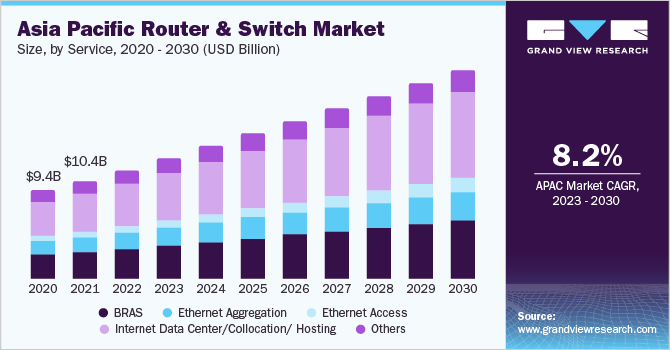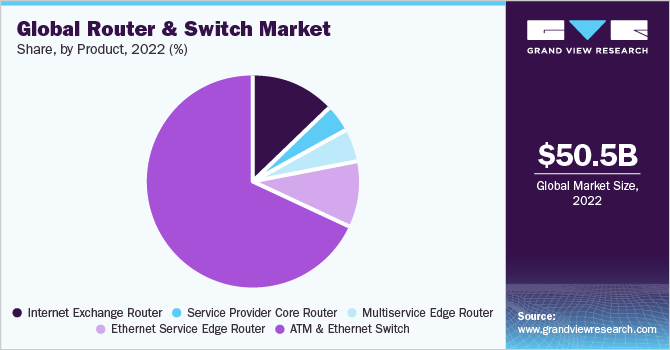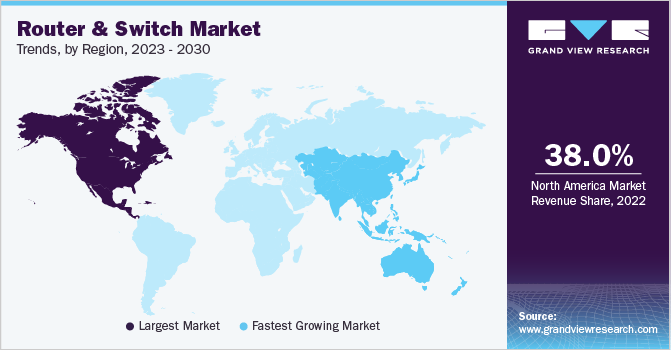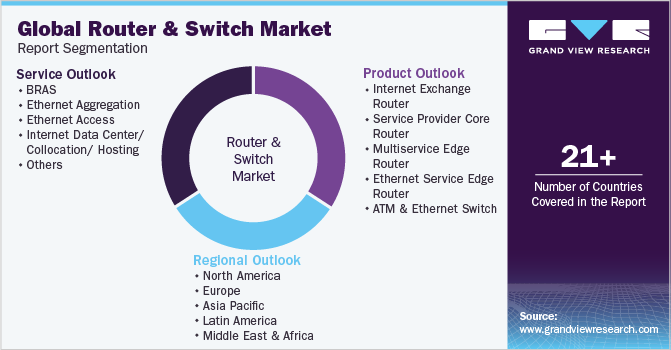
Router And Switch Market Size, Share & Trends Analysis Report By Product (Internet Exchange Router, Service Provider Core Router, Multiservice Edge Router, Ethernet Service Edge Router), By Service, By Region, And Segment Forecast, 2023 - 2030
- Report ID: 978-1-68038-505-2
- Number of Report Pages: 102
- Format: PDF
- Historical Range: 2017 - 2021
- Forecast Period: 2023 - 2030
- Industry: Technology
Router And Switch Market Size & Trends
The global router and switch market size was valued at USD 50.50 billion in 2022 and is expected to grow at a compound annual growth rate (CAGR) of 6.3% from 2023 to 2030, owing to the increased demand for network connectivity. Enterprises are adopting digital technology to improve business operations. With the development of cloud computing, IoT, and other technologies, the need for fast and reliable network connectivity has increased significantly, leading to a corresponding increase in the demand for routers and switches. Further, growing internet-enabled devices across all the developed and developing economies across the globe have propelled the growth of the market.

The advancement of cloud computing, 5G technology, and the Internet of Things (IoT) have also contributed to the growth of the market. Major technology companies, such as Huawei, Cisco Systems, and Juniper Networks, have a strong presence, providing various networking solutions to customers. For instance, in October 2022, Cisco Systems Inc., a digital communication technology provider, will set up a new manufacturing facility in India. The new manufacturing facility will produce mobility, network, and data center products, including routers, switches, access points, endpoints, and controllers.
The growing e-commerce industry is driving the demand for routers and switches as online businesses seek to improve their network infrastructure and connectivity. As the number of connected devices increases, managing and controlling these devices effectively becomes essential, leading to an increased demand for routers and switches with advanced network management capabilities. The growth in the number of connected devices has led to increased demand for routers and switches with higher capacity to handle increased traffic and data transfer. The increase in connected devices has also increased security concerns, leading to a demand for routers and switches that can provide secure connectivity and protect against cyber threats.
The growing potential of IoT has attracted significant investment from both private and public sectors, driving the growth of IoT. Along with the Internet of Things (IoT) development, there is a growing demand for routers and switches that can support IoT-specific protocols and provide secure connectivity for IoT devices. For instance, in February 2023, Oracle Corporation announced its plan to invest USD 1.5 billion in Saudi Arabia to build data center infrastructure in the region. Besides, in February 2023, Microsoft Corporation announced additional expenses on a new cloud data center in Saudi Arabia.
The pandemic led to a surge in remote work and distance learning, increasing the demand for reliable and high-performing networking equipment. It also resulted in supply chain disruptions, leading to shortages of critical components and affecting the production and delivery of routers and switches. Consequently, the economic downturn caused by the pandemic reduced IT spending, causing a slowdown in the adoption of new networking equipment. As a result, the pandemic accelerated the shift to cloud services, reducing the demand for traditional routers and switches and increasing the demand for cloud-based networking solutions. The pandemic changed the networking requirements of businesses, leading to an increased demand for solutions that support remote work and distance learning. Overall, the COVID-19 pandemic has had positive and negative effects on the market, leading to a change in demand for different types of networking equipment.
Product Insights
The ATM & ethernet switch segment led the market in 2022, accounting for over 67% share of the global revenue. The ATM (asynchronous transfer mode) and ethernet switch are a subset of the larger networking, market for router and switch. As more data-intensive applications and services emerge, demand for high-speed networking solutions is increasing, driving growth in the ATM & ethernet switch. Additionally, the convergence of ATM, ethernet, and other networking technologies is leading to the development of multi-protocol switch solutions, which offer greater flexibility and scalability to businesses. The ATM provides high-speed data transfer at up to gigabit speeds, making it suitable for demanding multimedia and video conferencing applications. It also allows for easy expansion as network requirements grow, making it an attractive choice for large networks.
The service provider core router segment is expected to showcase lucrative growth over the forecast period. These routers are the backbone of service provider networks and deliver high-speed, reliable internet connectivity to consumers and businesses. Service providers are investing in new service provider core routers to support the deployment of 5G networks, which require high-speed, low-latency connectivity. Besides, cybersecurity threats continue to increase, and service provider core routers are becoming increasingly sophisticated in their security features, including encryption, firewalls, and intrusion detection systems. Additionally, there is a growing demand for higher-bandwidth routers, with the emergence of 400G and 800G routers offering significantly higher speeds than current 100G routers.
Service Insights
The internet data center/collocation/hosting segment dominated the market and accounted for over 38% share of the global revenue in 2022. The growth is attributed to the increased demand for high-performance, scalable, and secure network solutions. With the growing number of connected devices and the increasing reliance on cloud-based services, there is a need for routers and switches that can handle large amounts of data traffic and provide advanced network security features. To meet these demands, many manufacturers focus on developing routers and switches that can support multi-gigabit and 10-gigabit ethernet, software-defined networking (SDN), and security features such as firewalls and VPNs. Additionally, the trend toward edge computing and the Internet of Things (IoT) is driving the need for smaller, more compact, and low-power routers and switches that can be deployed in remote locations.

The ethernet access segment is anticipated to register the highest CAGR over the forecast period as there has been an increase in the shift towards higher-speed ethernet connectivity. 10-gigabit ethernet (10GbE) has become increasingly popular for data centers, while multi-gigabit ethernet technologies such as 2.5GbE and 5GbE are gaining traction in the enterprise market for faster connectivity to devices such as wireless access points and network-attached storage. Additionally, there is a growing demand for 25-gigabit ethernet (25GbE) and 40-gigabit ethernet (40GbE) to meet the increasing bandwidth requirements of data centers. Besides, adopting software-defined networking (SDN) and network function virtualization (NFV), integrating IoT and AI/ML capabilities, drives the demand for ethernet access and network optimization. These technologies allow for greater network flexibility, efficiency, and intelligence, enabling organizations to manage their ethernet networks better.
Regional Insights
North America dominated the market and accounted for over 38% share of the global revenue in 2022, owing to the rapid adoption of advanced technologies across regional multinational companies. Rising fixed broadband traffic and increasing mobile data traffic propel service providers to upgrade their core networks, mobile backhaul, aggregation, and access in the North American regions. There has been a growing trend towards deploying software-defined networking (SDN) and network functions virtualization (NFV) technologies, creating a growing market for software-based routers and switches. The government has made significant investments in infrastructure to support the growth of technology, including developing high-speed networks and deploying new network infrastructure. For instance, in May 2021, the Government of Canada announced making triple spectrum available for Wi-Fi to support rural connectivity, competition, and deployment of 5G technologies in the country. Further, it will offer access to the 6GHz spectrum which will support higher speeds and higher user capacity for wireless devices connected to Wi-Fi routers.

The Asia Pacific region is anticipated to witness significant growth in the router & switch owing to factors such as the growth of the internet and mobile usage, increasing adoption of cloud computing, and the growth of the IT industry in countries such as China, India, and Japan. Operators in the Asia Pacific region are actively promoting the benefits of 5G technology, the services it can enable, and the use cases and services that will benefit consumers the most, such as virtual and augmented reality, autonomous vehicles, and smart cities. For instance, in October 2022, Cisco Systems Inc., a digital communication technology provider, will set up a new manufacturing facility in India. The new manufacturing facility will produce mobility, network, and data center products, including routers, switches, access points, endpoints, and controllers.
Key Companies & Market Share Insights
Various well-established multinationals and several small and medium vendors characterize the global router and switch market. Significant players focus their R&D efforts on releasing the most recent technologies to boost access speed and expand router and switch space. Furthermore, many suppliers are increasing their global reach to strengthen their market position and revenues. Such initiatives are expected to increase the router and switch equipment adoption rate. Router and switch companies aggressively pursue organic and inorganic tactics to expand their global footprints. For instance, in November 2022, MaxLinear, Inc., an American hardware company, collaborated with EDIMAX Technology Co., Ltd. The collaboration intends to provide a consolidated 2.5G high-speed five-port switch solution to the small & medium business and home markets. Besides, in December 2022, Edgecore Networks Corporation announced the launch of the AGR400 series, a new generation of high-performance aggregation router family for opening, 5g network, internet peering, and aggregation applications. Some prominent players in the global router and switch market include:
-
Actelis Networks, Inc.
-
Adtran
-
ADVA Optical Networking
-
ALE International
-
Cisco Systems, Inc.
-
Ribbon Communications Operating Company, Inc.
-
Telefonaktiebolaget LM Ericsson
-
EXTREME NETWORKS, INC.
-
Dell Technologies Inc.
-
Huawei Technologies Co., Ltd.
Router And Switch Market Report Scope
|
Report Attribute |
Details |
|
Market size value in 2023 |
USD 55.00 billion |
|
Revenue forecast in 2030 |
USD 84.12 billion |
|
Growth Rate |
CAGR of 6.3% from 2023 to 2030 |
|
Base year for estimation |
2022 |
|
Historical data |
2017 - 2021 |
|
Forecast period |
2023 - 2030 |
|
Report updated |
April 2023 |
|
Quantitative units |
Revenue in USD million and CAGR from 2023 to 2030 |
|
Report coverage |
Revenue forecast, company ranking, competitive landscape, growth factors, and trends |
|
Segments covered |
Product, service, region |
|
Regional scope |
North America; Europe; Asia Pacific; Latin America; MEA |
|
Country scope |
U.S.; Canada; U.K.; Germany; China; Japan; India; Brazil, Mexico |
|
Key companies profiled |
Actelis Networks, Inc.; Adtran; ADVA Optical Networking; ALE International; Cisco Systems, Inc.; Ribbon Communications Operating Company, Inc.; Telefonaktiebolaget LM Ericsson; EXTREME NETWORKS, INC.; Dell Technologies Inc.; Huawei Technologies Co., Ltd. |
|
Customization scope |
Free report customization (equivalent up to 8 analysts' working days) with purchase. Addition or alteration to country, regional, and segment scope. |
|
Pricing and purchase options |
Avail customized purchase options to meet your exact research needs. Explore purchase options |
Global Router And Switch Market Report Segmentation
This report forecasts revenue growth at the global, regional, and country levels and provides an analysis of the latest industry trends and opportunities in each of the sub-segments from 2017 to 2030. For this study, Grand View Research has segmented the global router and switch market report based on product, service, and region:

-
Product Outlook (Revenue, USD Million, 2017 - 2030)
-
Internet Exchange Router
-
Service Provider Core Router
-
Multiservice Edge Router
-
Ethernet Service Edge Router
-
ATM & Ethernet Switch
-
-
Service Outlook (Revenue, USD Million, 2017 - 2030)
-
BRAS
-
Ethernet Aggregation
-
Ethernet Access
-
Internet Data Center/Collocation/ Hosting
-
Others
-
-
Regional Outlook (Revenue, USD Million, 2017 - 2030)
-
North America
-
U.S.
-
Canada
-
-
Europe
-
Germany
-
U.K.
-
-
Asia Pacific
-
China
-
India
-
Japan
-
-
Latin America
-
Brazil
-
Mexico
-
-
Middle East & Africa
-
Frequently Asked Questions About This Report
b. The global router and switch market size was estimated at USD 50.50 billion in 2022 and is expected to reach USD 55.00 billion in 2023.
b. The global router and switch market is expected to grow at a compound annual growth rate of 6.3% from 2023 to 2030 to reach USD 84.12 billion by 2030.
b. North America dominated the router and switch market with a share of 38.7% in 2022. This is attributable to the increasing mobile backhaul investments.
b. Some key players operating in the router and switch market include Cisco; Alcatel-Lucent; Huawei Technologies; Juniper Networks; and ZTE Corporation amongst others.
b. Key factors that are driving the market growth include the increased usage of high-speed Gigabit Ethernet, rising adoption of PoE for varied applications, and convergence of business and residential networks.
We are committed towards customer satisfaction, and quality service.
"The quality of research they have done for us has been excellent."




